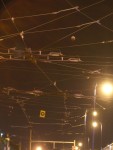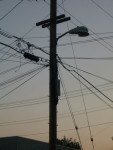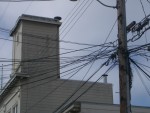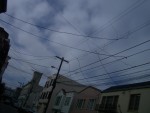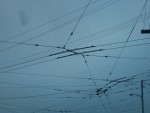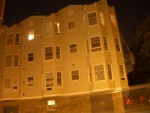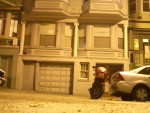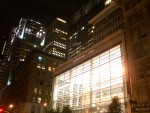October 30, 2004
More wires and buildings
The two first photos in each series are of the lunar eclipse we just had. The moon is the little orange thing in the upper righthand corner.
And have I said how much I love my Pentax Optio s4i? It's a great little camera. So good, in fact, that I lost one in Bristol earlier this year and bought an identical one as soon as I got back.
October 28, 2004
Form Factors
It'll be interesting to see how new technology integrates with people's existing home environments. Here's a nice description of how matching people's expectations with the new demands of consumer equipment, from this article:
The bulky armoires people already have in their homes hide the flat panels' sleekness, the main motivation for investing thousands of dollars in them. As more people are buying these televisions, new options are being designed, including compact consoles.
This is an interesting replay of the tension that happened when radio equipment became small enough that it was not longer necessary to have a big bulky piece of furniture and the popularity of tabletop models took off. People's attitudes of what constitututed an appropriate relationship between the furniture in their homes and the technology shifted in response to both the shifting technology constraints and their comfort level with the new tech. This is, of course, continuously going on--after all, we repurposed armoires from holding clothing to TV's--but it's fascinating to watch.
The article also mentions this amusing product, the In-Vis-O-Track. With a name that's out of the 30s (where it would have been called the "Inviso-Track-ola"), it's described thus:
At the touch of a hand-held transmitter, you can now conceal and reveal a RECESSED TV, or any other item behind your favorite painting.
I'll let all of the pop cultural theorists gnaw on how that reinterprets the shifting relationship of art to media in our culture. ;-)
October 25, 2004
Primer: geek porn
Cassidy took me to see Primer, a film that he saw at Sundance, last night. It's an ultra low budget sci-fi film, and geek porn of the first order. It's a classic sci-fi story, one that could have been written in the 50s, but the context is interesting. It's set the world of startups, venture capital, technology parks and day trading. Classically, the ultimate conflict is a mixture of loyalty, greed and lust, but the staging is purely late 90s mythology, which may make it the first film I've seen that uses that world as the backdrop, and not the focus.
It's also really good. Or, I should say, the first 3/4 of it is. The last quarter gets confusing, and that's part of the point of the story, but I think it could have been structured to pull the audience along with it a bit better. Eternal Sun of the Spotless Mind had a similar self-reflexive plot, but it managed to keep the audience just on this edge of comprehensibility. This film is more confusing than that. However, it's still a tremendous achievement and if you're in San Francisco, you should go see it at the Four Star, an endangered SF theater. Go there...and buy a t-shirt, too, since they have cool t-shirts and could use the money.
Oh, and the other amusing thing about the film is that it was apparently made on a $7000 budget, though it doesn't show it. I'm looking forward to what the filmmaker makes next.
October 19, 2004
RFID playground toystore
I was visiting my friends Moses and Lucie and their kids, Felix and Milo, in Berkeley last week. We went to a public playground near their house that had all kinds of toys scattered about (it's tellingly Berkeley that the toys don't walk away and parents regularly bring more for everyone to share). The thought of a store based on that model occurred to me: have a mall store--malls, of course are primary suburban safe play spaces for kids--where parents swipe their credit card to get themselves and their kids in. They get one of those amusement park or hospital-like plastic wristbands. Inside, it's a large open playspace and cafe, with lots of toys for the kids to play with, and new ones constantly being added. Each toy has an RFID tag in it. If a child wants the toy, falls in love with the toy, then the parents and kids just walk out with it--the RFID tags automatically charge the price of the toy to the credit card the parents swiped to get in, based on proximity with their wristband RFID.
I can see that there are a bunch of potential logistical and financial model problems with this (there's a reason that toys are kept in sturdy packages in toy stores, after all, and I bet it's primarily because of the margins). However, in terms of how a retail model can use technology and change to compete experientially in a realm where straight retail is now difficult, it seemed interesting to me.
The perfect robot
Here's a pretty hilarious story from Sync magazine, where Jake Bronstein--the author--tries to outfit his house with as many domestic robots as possible. I won't give away what happens, but his conclusion is that maybe robots that look like dogs and people aren't the future of robotics:
If I had to place a bet, I'd say when the robots take over the world, they won't look like anything we've seen in the movies. They'll probably look more like sinks. Or deep fryers. Or toilets.
I know I'm biased, but he's right.
October 18, 2004
Electrical engineers acknowledge social science
It's interesting to see how ideas slide around. In this article, in an electrical engineering publication, the thinking goes from "component manufacturers are saying that this ubiquitous computing thing is the next big thing" to "people do funny stuff with their personal technology" to "someone should decide how the electronics should be integrated into people's lives" to
It doesn't take much imagination to see that if you are involved in the development of personal portable electronic products, your engagement with the marketing department is only going to grow as time passes. The subtle nuances of how users actually handle the gadgets in a social context could well set the course of product development.
Which, of course, is what user centered design people have been saying all along, but it's interesting to see how it's being recognized by at least an engineering publication. It'll take it a while, I suspect, to become engineering doctrine, but at least the acknowledgement that ideas come from end users, rather than just going to them, is important.
It's still funny though, that although at least this article recognizes social science, there's still a level of discomfort with the whole idea, as the last line shows:
Your marketing colleagues might come to include as many social scientists as "hard" scientists. I will leave it to you to decide whether that prospect is appealing.
October 11, 2004
Egovernment Usability
About a year ago I wrote a chapter for a book that Macromedia was releasing. I just realized that although the book is nowhere to be found, at least they've mentioned it (PDF) on their site (here's the page it's linked from--extra credit if you can figure out where on that page it's linked--HINT: it's not the upper lefthand corner ;-). My chapter is on e-government usability.
I don't believe I have the rights to share the chapter online, but if anyone wants to know what I said, drop me a note and I'll send you a copy.
Design Engaged
I'm really honored to have been invited by Andrew Otwell to participate in his Design Engaged conference in Amsterdam in November.
I'm probably going to be talking about agile UI development--Andrew has expressed interest in this--or maybe I'll wave my hands and rant about the coming emergent age of animism and domestic technology, but--frankly--that hardly matters. I'll be primarily there to listen, since the speaker lineup is great and the conference looks to be a blast of big, deep ideas and synergy. I think it'll be a lot of fun, too.
Thank you, Andrew, and I'll be getting you my topic by Friday. ;-)
October 07, 2004
Smart Cradle
A few weeks, old, but Victor sent me this link (to an Engadget piece) on a smart baby cradle.
Beds are a good platform for introducing technology and, more imporantly, young parents are a prime market for gadgets that make their infants safer or make their lives easier, so this makes a lot of sense. The amount of money that goes to kid tech is pretty huge, and with the continuing shift toward greater shared responsibility between parents, more dads--a prime technology consumer--are buying toys for their kids. Why else would there be $2000 titanium and leather baby strollers? (though, granted, that was a limited edition from Maclaren--but they still sold 1000--that's $2 million of titanium baby strollers sold!) Of course parents are also intensely cost-conscious as they realize how they've underestimated the costs of Baby, so technology needs to be cheaper (Neurosmith, the toy maker, probably went under because their very innovative technology toys had a price point of about $40, rather than the $20 or whatever parents were willing to pay for the technology), but technology is constantly getting cheaper, so it's a matter of time before the lines cross.
October 04, 2004
Herman-Miller Pink Noise Cubicles
Herman-Miller has started marketing a cubicle noise cancellation system (PDF) that produces pink noise. Pink noise sounds like white noise to the human ear, and thus effectively masks a lot of the background noisy frequencies of people talking and typing, thus making open office plans feel less open. H-M's solution is as follows:
Small speakers embedded in the “petals” that attach easily to the top of Resolve tall poles broadcast the patented spectrum.[...]
Quiet Technology™ sound masking attaches to furniture, so efficient
coverage results from targeting only those areas of the space that
require sound masking.[...]
Quiet Technology achieves these results by delivering an
Articulation Index (AI) of .2 or less, meaning that few words
(20 percent or less) spoken by people 12 to 16 feet away
are intelligible.
Remember the noise generators that used to sit in the corners of conference rooms in the 80s? (Or at least they used to be in conference rooms I was sitting in at the University of Michigan). I find that the reappearance of noise cancelling somewhat ironic, considering how much effort was spent on making open office plans with highly reflective exposed brick surfaces in the 90s, but it's also a recognition that people work differently now and that open office plans and a semblance of privacy need to coexist. It's interesting to see the privacy pendulum swing of office architecture: from 1900s tiny offices to 1920s Taylorized open work plans to 1960s cube farms to 1990s open offices, now back to some kind of privacy-centered idea.
This seems like a great opportunity for active noise cancellation (which is probably hella hard to do outside of headphones, but maybe someone's working on it) and using Bluetooth phone-sensitive cube walls to modulate the level of noise based on the number people in the vicinity, or feedback microphones that measure sound levels and adjust the volume of the pink noise dynamically (if that's appropriate for this kind of noise). And it's also time for someone to start writing pink noise Muzak. As I write this, I'm listening to Königsforst by Gas, which may as well be "music for pink-noise enabled office spaces."
Even further tangentially, H-M PDF starts with an interesting history of the use of sound-cancellation in office environments:
Early sound-masking systems installed in buildings in the 1960s simulated the sound of air moving by electronically filtering random noise produced by gas-discharge vacuum tubes. Loudspeakers in the ceiling distributed the amplified noise signal throughout the office. However, making human speech unintelligible required a volume level so high that the sound masking itself became a distracting annoyance. In the 1970s, electronically generated sound masking using frequency generators that shaped sound to better mask speech became more practical and worked well when installed correctly. Ten years later, researchers began studying 1/f noise, the phenomenon also known as “flicker” or “pink” noise. Targeting “pink” noise to match the frequencies of human speech raised the threshold of audibility just enough to mask intelligibility without requiring the higher volumes used in earlier systems.
Sketching and prototyping
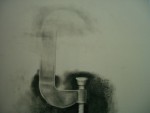
I've been thinking about what sketching can teach us about iterative prototyping. Years ago I had the pleasure of working with Lawrence Marvit on a project. Lawrence is an immensely talented illustrator and animator. He brought a bag of differently colored pencils and while we talked about ideas, he sketched. He started with lighter colored pencils, then moved to darker and darker ones as our ideas developed. Only when our ideas were pretty clear did he use a black pencil. It was great. A short period—just a couple of evenings—but one of my favorite collaboration experiences.
It's been almost 10 years since that experience, and thinking back made me realize how frustrated I've been with all of my software/hardware experiences in comparison. Even in the hands of experienced practitioners, the tools just seem limited and limiting. There's much energy spent managing the tool, even when the tool is familiar. So I decided to think about what it is that makes sketching on paper a different prototyping experience and what are the qualities that prototyping tools can aspire to.
I think that there are several things that make drawing on paper particularly good prototyping medium:
- It's fast. You can sketch very quickly and need almost nothing to do it. You can change a sketch quickly by just sketching over what you just sketched. You can make another sketch. These prototypes can communicate an immense amount in a short amount of time. And time is important when exploring ideas. The less time it takes to explore an idea, the more ideas can be explored.
- It's provisional. You know a sketch is not the final product. There are a bunch of indicators that tell you it's not the real thing. The classic visual indicators of a sketch are that lines aren't straight, circles aren't round, and lines go through endpoints, instead of ending cleanly. The nonphotorealistic computer graphics people have been investigating these ideas for a while (another link), but the point is that how sketching looks sends signals that it's not the real thing, so it's easier to keep thinking about the core ideas, instead of being distracted by the details. In consulting, we often have to go to great lengths to communicate the finality, or lack thereof, of our deliverables, and much client-consultant misunderstanding comes from the client thinking something is done, when it's not.
- It's a history. Sketching shows you in one place the record of successful ideas, experiments and failures. You're constantly defining the envelope of what's acceptable and what's not. When you've finally reached a point, you can mark the final version (outlining in ink what has been penciled in, for example), but the history is still there. Jim Dine, the artist, used to erase and abrade his drawings, intentionally leaving a shadow history. History is feedback. It let's you know where to not go again (you know the line about people being doomed to repeat it?).
So if paper is the medium to emulate, how do other prototyping methods stack up? I started writing about how different practices prototype, but I realized that I didn't know enough about each field to do a good job of it. However, that didn't stop me from producing a table that attempts to score media on how easy it is to prototype in them, based on my three criteria. I also included a short list of history media, since I think that's the thing that's most lacking in most prototyping systems. This, too, is a sketch of sorts.
| For | Methods | History Medium | Speed | Provisional | History | Score |
| Drawing | Sketching | Paper | 5 | 5 | 5 | 125 |
| Writing | Drafts | Revisions, Change tracking | 5 | 4 | 3 | 60 |
| Architecture | Wireframes, models | Series of models | 3 | 4 | 1 | 12 |
| Software | Iterative development | Revision control | 2 | 3 | 4 | 24 |
| Screen-level interfaces | Prototyping | Paper, wireframes, Flash, toolkits | 2 | 3 | 1 | 6 |
| Interaction design | Flowchart | Series of designs | 3 | 2 | 2 | 12 |
| Hardware | Prototyping | Hardware toolkits | 1 | 1 | 3 | 3 |
| Music | Rehearsing | Tapes, scores | 5 | 5 | 1 | 25 |
| Theater | Rehearsing | Script, Video | 5 | 5 | 3 | 75 |
| Information Architecture | Sketching | Series of diagrams | 4 | 2 | 1 | 8 |
(to exaggerate the score sale, I've multiplied the numbers, rather than just adding them)
Part of my agenda in doing this was to understand just how bad prototyping in hardware is—it's really bad, even with all of the new toolkits on the market—and if there are other media that physical computing can learn from when thinking about how to prototype its systems. I'm not sure I have an answer to that yet but I'm starting to think about it, just as I'm starting to evaluate some of the hardware prototyping systems out there to see if I can learn from their thinking.
Here are the ones I know about:
One final thing: after I wrote most of this (and a bunch more, which ended up on the cutting room floor because it makes even less sense) back in July, I discovered that Bill Buxton talked about this very thing in a series of lectures. I haven't been able to find a transcript of what he said, but it's interesting to me that these ideas are appearing now. It says to me that the field is maturing in a way that the constraints of the medium are giving way to the constraints in our abilities to use it creatively and efficiently. Buxton, as always, is in the forefront.
Oh, and there are a bunch more excellent Jim Dine drawings in the National Gallery of Art show. Dine rocks.
